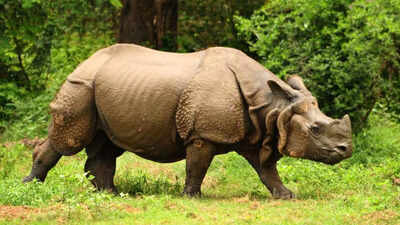Can science revive dead rhinos? The answer may shock you | – The Times of India

Scientists in the UK have revived living cells from a southern white rhino that died in 2021, offering new hope for conservation efforts. This breakthrough, reported by the BBC, was achieved by Nature’s SAFE, a Shropshire-based charity. They successfully cultured millions of cells from a preserved skin sample taken before the rhino’s death. This pioneering work could allow scientists to create new egg or sperm cells, helping to restore endangered populations. The technique, already proven in mice, marks a major step forward in protecting species like the southern white rhino and others at risk of extinction.
A new discovery of rhino revival from dead to new life
According to a BBC report, a skin sample taken from a rhino that died in 2021 is now offering fresh hope for conservation which has only become possible because of the pioneering efforts by a UK wildlife charity.The southern white rhino which lived at Whipsnade Zoo passed away at the age of 40. In the wake of its death, the veterinary staff collaborated with three specialist organizations to preserve tissue samples. Now, Nature’s SAFE which is a conservation charity based in Whitchurch, Shropshire, has successfully cultivated millions of living cells from that sample.
Rhino’s revival discovery: a significant step to development
This development represents a significant step toward a groundbreaking technique that may one day allow scientists to create viable egg or sperm cells from preserved rhino tissue, offering a new path for reviving endangered populations. Although the rhino died in 2021, new technology could allow her genetic material to support the southern white rhino population for generations to come. Before her death, conservation charity Nature’s SAFE collected a skin sample from her ear while she was still alive. The cells were carefully frozen at –196°C, with the goal of preserving them long-term. Scientists hope that once melted, the cells can be revived and multiplied to produce new cell lines.A representative from the charity explained that while the process may seem like something out of science fiction, similar techniques have already been successful in mice ,showing promising potential for helping other species reproduce.
Expert’s efforts for Rhino revival from dead to new life
In April, the team carefully took the rhino’s frozen cells out of storage and brought them back to room temperature. Even though the rhino died nearly four years ago, they were able to grow new cells from the sample. Lab technician Lucy Morgan, who helped make it happen, said that the cells still carry the rhino’s living DNA and can now be used to help protect the species, even though the animal is no longer alive. Nature’s SAFE, which is also known as the “bio bank” has collected and preserved biological material from 300 different animal species — including 37 that are critically endangered and four that no longer exist in the wild.
Goal of Nature’s SAFE for Rhino’s new life from dead
The organization’s goal is to help prevent animal extinction by protecting genetic diversity. It supports advanced reproductive technologies like artificial insemination and IVF to help maintain and rebuild strong, healthy wildlife populations. Debbie Rolmanis, the chief operations officer, explained: “By collecting and growing skin cells from endangered animals, we’re creating a living library of genetic material. This resource could one day help boost the genetic health of struggling species and stop them from disappearing.” She added that skin cells are especially useful because they’re easy to collect and can be reproduced endlessly. Unlike other resources, they aren’t limited, making them a powerful and reliable way to preserve an animal’s DNA in working condition.Tullis Matson, founder and chair of the charity, shared his excitement about successfully reviving the rhino’s cells, calling it a potential breakthrough for conservation. “This is a major step forward,” he said. “We’ve now shown that the rhino’s cells are still alive and usable nearly four years after her death.” He explained that this achievement could be vital for saving other critically endangered animals — such as the mountain chicken frog and the Lake Pátzcuaro salamander — that might otherwise face extinction. Thanks to advances in bio-banking, their survival is now more possible than ever.Also read: Black Holes explained: Unraveling the facts of space’s cosmic mystery
















